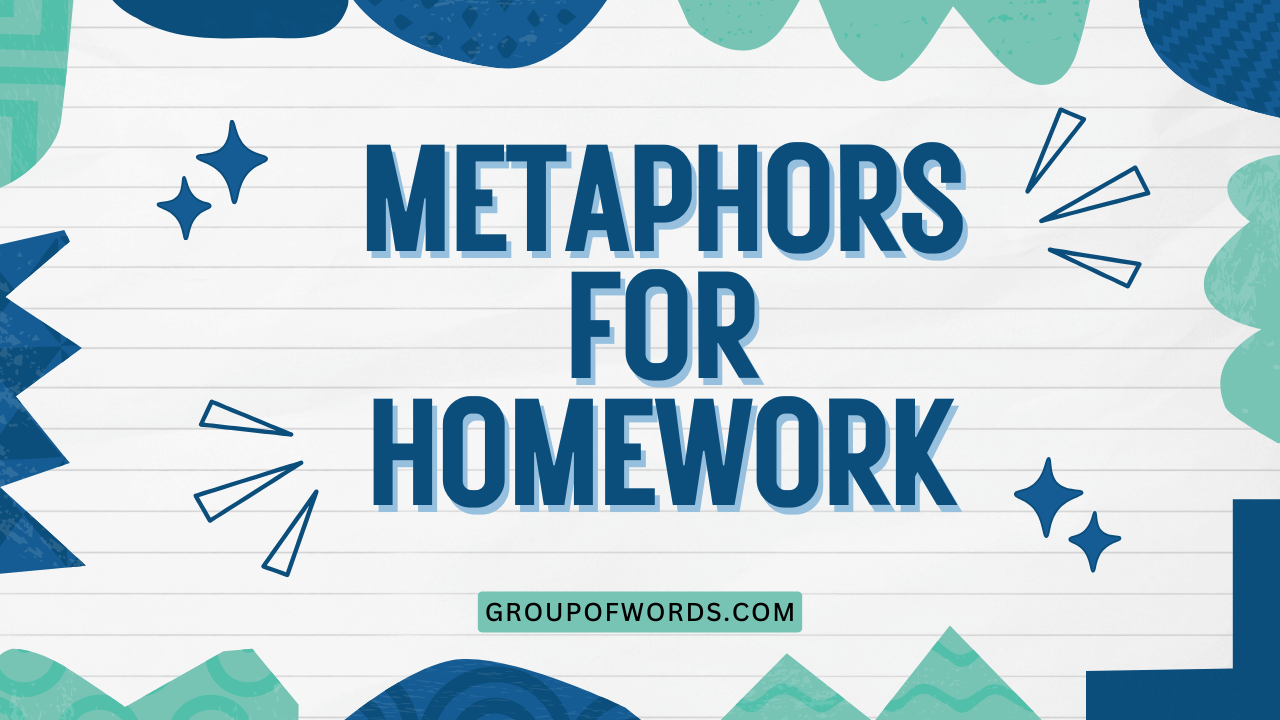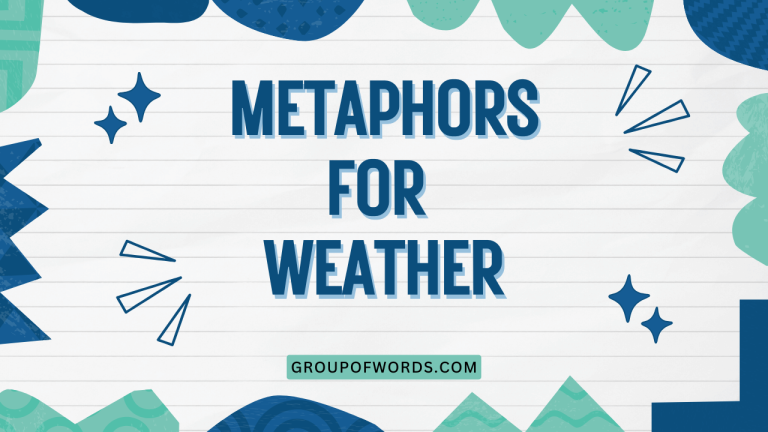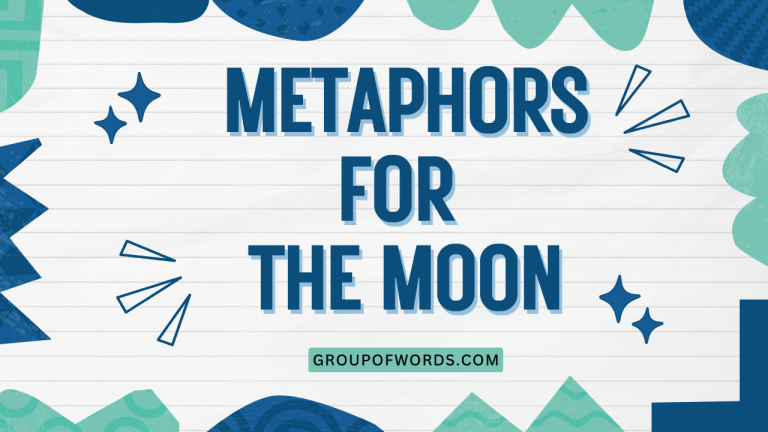Homework as a Hurricane: Exploring Metaphors for Schoolwork
Homework: the word itself can evoke a range of emotions, from mild annoyance to outright dread. But have you ever stopped to consider how we talk about homework?
Often, we use metaphors to describe it, unconsciously shaping our perception of this ubiquitous part of student life. Understanding these metaphors can help us better manage our attitudes towards homework and even find more effective strategies for tackling it.
This article will delve into the fascinating world of metaphors for homework, exploring their meanings, implications, and how they impact our learning experience. This guide is perfect for students of all levels, educators, and anyone interested in the power of language in shaping our understanding of the world.
Whether you’re a student struggling with a mountain of assignments or a teacher looking for new ways to inspire your students, this exploration of homework metaphors will offer valuable insights and practical tips. Let’s embark on this linguistic journey and discover the hidden meanings behind the words we use to describe homework!
Table of Contents
- Introduction
- What is a Metaphor?
- Structural Breakdown of a Metaphor
- Common Metaphors for Homework
- Examples of Homework Metaphors in Use
- Rules for Using Metaphors Effectively
- Common Mistakes When Interpreting Metaphors
- Practice Exercises
- Advanced Topics: Extended Metaphors and Symbolism
- Frequently Asked Questions
- Conclusion
What is a Metaphor?
A metaphor is a figure of speech that directly compares two unrelated things. Unlike a simile, which uses “like” or “as” to make a comparison (e.g., “Homework is like a mountain”), a metaphor states that something *is* something else (e.g., “Homework is a mountain”).
The power of a metaphor lies in its ability to transfer qualities or characteristics from one thing to another, creating a new understanding or perspective. Metaphors are essential tools in language, allowing us to express complex ideas in a vivid and memorable way.
They are not just decorative elements; they shape our thinking and influence how we perceive the world.
In essence, a metaphor highlights similarities between two seemingly different concepts, creating a new and often more insightful meaning. This process involves understanding both the literal and figurative meanings of the words used and recognizing the underlying connection being drawn.
By understanding the nuances of metaphors, we can better appreciate the richness and complexity of language.
Structural Breakdown of a Metaphor
A metaphor typically consists of two main elements: the tenor and the vehicle. The tenor is the subject being described (in our case, homework), while the vehicle is the object or concept used to describe it (e.g., a mountain, a monster). The metaphor works by transferring qualities from the vehicle to the tenor, creating a new understanding of the tenor. For instance, if we say “Homework is a mountain,” the tenor is homework, and the vehicle is a mountain. The metaphor implies that homework is large, difficult to climb, and requires significant effort to overcome, drawing on our understanding of mountains.
The effectiveness of a metaphor depends on the reader’s ability to recognize the connection between the tenor and the vehicle. A strong metaphor creates a clear and compelling image, while a weak metaphor may be confusing or ineffective.
Understanding the structural components of a metaphor allows us to analyze its meaning and appreciate its impact on our understanding.
Common Metaphors for Homework
Homework, due to its demanding nature and impact on students’ lives, is frequently described using various metaphors. These metaphors often reflect the emotional and psychological experiences associated with schoolwork.
Let’s explore some of the most common categories:
Homework as a Burden
This is perhaps the most prevalent metaphor for homework. It portrays homework as a heavy weight, something that weighs one down and restricts freedom.
It emphasizes the feeling of being overwhelmed and burdened by academic tasks.
Homework as a Monster
This metaphor depicts homework as a threatening and fearsome entity. It highlights the anxieties and stress associated with completing assignments, often suggesting that homework is an insurmountable challenge.
Homework as an Obstacle
Here, homework is seen as a barrier standing in the way of achieving goals or enjoying leisure time. This metaphor focuses on the frustration and difficulty of overcoming the challenges posed by schoolwork.
Homework as a Journey
This metaphor offers a more positive perspective, portraying homework as a path towards learning and growth. It emphasizes the process of acquiring knowledge and developing skills through academic tasks.
Homework as an Opportunity
This is another positive metaphor that views homework as a chance to explore new ideas, deepen understanding, and improve academic performance. It highlights the potential benefits and rewards of engaging with schoolwork.
Examples of Homework Metaphors in Use
To illustrate the different types of homework metaphors, let’s explore a variety of examples. These examples will demonstrate how metaphors can shape our perception of homework and influence our approach to academic tasks.
The following table presents examples of homework being portrayed as a burden. Notice the connotations of weight, restriction, and oppression in these metaphors.
The metaphors convey the sense of homework being a heavy load that hinders one’s freedom and enjoyment.
| Metaphor | Explanation |
|---|---|
| Homework is a ball and chain. | Implies that homework restricts freedom and ties one down. |
| Homework is a lead weight dragging me down. | Conveys the feeling of being weighed down and slowed by homework. |
| Homework is an albatross around my neck. | Suggests that homework is a constant burden and source of guilt. |
| The homework load is crushing me. | Highlights the overwhelming pressure and weight of assignments. |
| Homework is a heavy backpack I can’t take off. | Emphasizes the constant presence and burden of schoolwork. |
| Homework is my cross to bear. | Implies that homework is an unavoidable and unpleasant duty. |
| Homework is a yoke around my shoulders. | Conveys the feeling of being burdened and controlled by homework. |
| Homework is a millstone around my neck. | Suggests that homework is a heavy and oppressive burden. |
| Homework is a ton of bricks. | Highlights the heavy and overwhelming nature of assignments. |
| Homework is a crushing weight on my shoulders. | Emphasizes the physical and emotional burden of schoolwork. |
| Homework is a relentless anchor. | Implies that homework holds one back and prevents progress. |
| Homework is a suffocating blanket. | Conveys the feeling of being overwhelmed and stifled by schoolwork. |
| Homework is an inescapable obligation. | Highlights the compulsory and burdensome nature of assignments. |
| Homework is a relentless demand. | Emphasizes the constant pressure and expectations of schoolwork. |
| Homework is a tiresome chore. | Suggests that homework is a repetitive and unpleasant task. |
| Homework is a tedious obligation. | Conveys the feeling of being bored and burdened by assignments. |
| Homework is a grueling task. | Highlights the demanding and exhausting nature of schoolwork. |
| Homework is a heavy responsibility. | Emphasizes the pressure and obligations associated with assignments. |
| Homework is a relentless obligation. | Implies that homework is an unending and burdensome duty. |
| Homework is a tiresome duty. | Suggests that homework is a repetitive and unpleasant task. |
| Homework is a weighty responsibility. | Conveys the feeling of being burdened and pressured by schoolwork. |
| Homework is a heavy burden. | Highlights the oppressive and overwhelming nature of assignments. |
| Homework is a crushing obligation. | Emphasizes the pressure and demands associated with schoolwork. |
The following table presents examples of homework being portrayed as a monster. These metaphors emphasize the fear, anxiety, and overwhelming nature of homework.
The metaphors convey a sense of dread and the feeling of being confronted by an insurmountable challenge.
| Metaphor | Explanation |
|---|---|
| Homework is a monster under my bed. | Implies that homework is a hidden source of fear and anxiety. |
| Homework is a hydra; cut one head off, and two more appear. | Conveys the feeling that homework is an endless and multiplying task. |
| Homework is a looming beast. | Suggests that homework is a threatening and unavoidable presence. |
| Homework is a black hole, sucking up all my time. | Highlights the time-consuming and overwhelming nature of assignments. |
| Homework is a relentless predator. | Emphasizes the aggressive and unforgiving nature of schoolwork. |
| Homework is a daunting dragon to slay. | Implies that homework is a challenging and fearsome task to overcome. |
| Homework is a wicked witch casting a spell over my weekend. | Conveys the feeling that homework ruins leisure time and enjoyment. |
| Homework is a shadow that never leaves my side. | Suggests that homework is a constant and inescapable presence. |
| Homework is a fearsome ogre guarding the gate to fun. | Highlights the obstacle that homework presents to enjoying free time. |
| Homework is a relentless tormentor. | Emphasizes the constant stress and anxiety caused by schoolwork. |
| Homework is a cruel taskmaster. | Implies that homework is a demanding and unforgiving obligation. |
| Homework is a relentless nightmare. | Conveys the feeling of being trapped and overwhelmed by schoolwork. |
| Homework is a lurking menace. | Suggests that homework is a hidden source of stress and anxiety. |
| Homework is a terrifying ordeal. | Highlights the challenging and overwhelming nature of assignments. |
| Homework is a relentless demon. | Emphasizes the negative and destructive impact of schoolwork. |
| Homework is a wicked curse. | Implies that homework is an unfortunate and unpleasant burden. |
| Homework is a relentless foe. | Conveys the feeling of being in constant battle with schoolwork. |
| Homework is a fearsome challenge. | Highlights the difficulty and intimidation associated with assignments. |
| Homework is a relentless adversary. | Emphasizes the constant struggle and opposition presented by schoolwork. |
| Homework is a wicked torment. | Implies that homework is a source of constant stress and suffering. |
| Homework is a relentless burden. | Conveys the feeling of being weighed down and oppressed by schoolwork. |
| Homework is a fearsome ordeal. | Highlights the challenging and overwhelming nature of assignments. |
The following table presents examples of homework being portrayed as an obstacle. These metaphors focus on the idea that homework stands in the way of something else – free time, relaxation, or other activities.
The metaphors highlight the frustration and difficulty of overcoming the challenges posed by schoolwork.
| Metaphor | Explanation |
|---|---|
| Homework is a wall between me and the weekend. | Implies that homework prevents one from enjoying free time. |
| Homework is a hurdle I have to jump over. | Conveys the feeling of having to overcome a challenge to reach a goal. |
| Homework is a roadblock on the path to fun. | Suggests that homework is an obstacle preventing enjoyment. |
| Homework is a maze I have to navigate. | Highlights the complexity and difficulty of completing assignments. |
| Homework is a locked door, keeping me from my friends. | Emphasizes the isolation and restriction caused by schoolwork. |
| Homework is a thick fog clouding my mind. | Implies that homework makes it difficult to think clearly and relax. |
| Homework is a minefield I have to carefully cross. | Conveys the feeling of having to be cautious and avoid mistakes. |
| Homework is a deep chasm separating me from freedom. | Suggests that homework creates a significant barrier to enjoying free time. |
| Homework is a tangled web I have to unravel. | Highlights the complexity and confusion of completing assignments. |
| Homework is a sticky trap ensnaring my time. | Emphasizes the time-consuming and restrictive nature of schoolwork. |
| Homework is a high fence blocking my view. | Implies that homework prevents one from seeing beyond immediate tasks. |
| Homework is a winding path leading to nowhere. | Conveys the feeling of being lost and unproductive while doing assignments. |
| Homework is a dense forest obscuring the light. | Suggests that homework makes it difficult to find clarity and motivation. |
| Homework is a treacherous river I have to ford. | Highlights the challenges and difficulties of completing schoolwork. |
| Homework is a steep cliff I have to climb. | Emphasizes the effort and determination required to overcome assignments. |
| Homework is a dark tunnel I have to pass through. | Implies that homework is an unpleasant but necessary experience. |
| Homework is a thorny bush scratching at my peace. | Conveys the feeling of being constantly irritated and disturbed by schoolwork. |
| Homework is a relentless barrier. | Highlights the constant obstruction presented by assignments. |
| Homework is a daunting impediment. | Emphasizes the difficulty and intimidation of overcoming schoolwork. |
| Homework is a wicked obstruction. | Implies that homework is an unfortunate and unpleasant obstacle. |
The following table presents examples of homework being portrayed as a journey. These metaphors offer a more positive perspective, emphasizing the process of learning and growth.
The metaphors highlight the idea that homework is a path towards acquiring knowledge and developing skills.
| Metaphor | Explanation |
|---|---|
| Homework is a stepping stone to success. | Implies that homework is a necessary step towards achieving goals. |
| Homework is a path to enlightenment. | Conveys the idea that homework can lead to greater understanding. |
| Homework is a journey of discovery. | Suggests that homework can be an opportunity to learn new things. |
| Homework is a bridge to a better future. | Highlights the potential benefits of schoolwork for future opportunities. |
| Homework is a road map to knowledge. | Emphasizes the guidance and direction provided by assignments. |
| Homework is a voyage of learning. | Implies that homework can be an exciting and enriching experience. |
| Homework is a climb to the summit of understanding. | Conveys the effort and reward of achieving academic goals. |
| Homework is a quest for wisdom. | Suggests that homework can be a meaningful and purposeful endeavor. |
| Homework is a pilgrimage to knowledge. | Highlights the dedication and commitment required for academic success. |
| Homework is a trek through the landscape of learning. | Emphasizes the exploration and discovery involved in schoolwork. |
| Homework is a voyage to discovery. | Implies that homework can be an exciting and enriching experience. |
| Homework is a pathway to success. | Conveys the idea that homework can lead to greater achievements. |
| Homework is a journey to excellence. | Suggests that homework can be a means to achieve high standards. |
| Homework is a route to enlightenment. | Highlights the potential for homework to expand one’s understanding. |
| Homework is a voyage to knowledge. | Emphasizes the exploration and discovery involved in schoolwork. |
| Homework is a pathway to understanding. | Implies that homework can lead to a deeper comprehension of concepts. |
| Homework is a journey to mastery. | Conveys the idea that homework can help develop expertise and skills. |
| Homework is a route to wisdom. | Suggests that homework can be a means to gain insight and knowledge. |
| Homework is a voyage to achievement. | Highlights the potential for homework to lead to success and accomplishment. |
| Homework is a pathway to growth. | Emphasizes the potential for homework to foster personal and intellectual development. |
The following table presents examples of homework being portrayed as an opportunity. These metaphors emphasize the potential benefits and rewards of engaging with schoolwork.
The metaphors highlight the idea that homework is a chance to explore new ideas, deepen understanding, and improve academic performance.
| Metaphor | Explanation |
|---|---|
| Homework is a chance to shine. | Implies that homework provides an opportunity to demonstrate knowledge and skills. |
| Homework is a window to the world. | Conveys the idea that homework can expand one’s understanding of the world. |
| Homework is a golden opportunity. | Suggests that homework is a valuable and rewarding experience. |
| Homework is a chance to grow. | Highlights the potential for homework to foster personal and intellectual development. |
| Homework is a key to success. | Emphasizes the importance of homework for achieving academic and career goals. |
| Homework is a gateway to knowledge. | Implies that homework can open doors to new and exciting information. |
| Homework is a chance to excel. | Conveys the idea that homework provides an opportunity to achieve high standards. |
| Homework is a learning experience. | Suggests that homework is a valuable and enriching activity. |
| Homework is a springboard to achievement. | Highlights the potential for homework to launch one towards success. |
| Homework is a path to self-improvement. | Emphasizes the potential for homework to foster personal growth and development. |
| Homework is a chance to explore. | Implies that homework provides an opportunity to delve into new subjects and topics. |
| Homework is a window to understanding. | Conveys the idea that homework can expand one’s comprehension of concepts. |
| Homework is a golden opportunity to learn. | Suggests that homework is a valuable and rewarding learning experience. |
| Homework is a chance to develop skills. | Highlights the potential for homework to foster practical and intellectual abilities. |
| Homework is a key to unlocking potential. | Emphasizes the importance of homework for realizing one’s capabilities. |
| Homework is a gateway to higher education. | Implies that homework can open doors to further academic pursuits. |
| Homework is a chance to shine academically. | Conveys the idea that homework provides an opportunity to demonstrate knowledge and abilities. |
| Homework is a learning experience that enriches. | Suggests that homework is a valuable and enriching activity. |
| Homework is a springboard to future success. | Highlights the potential for homework to launch one towards future achievements. |
| Homework is a path to personal enrichment. | Emphasizes the potential for homework to foster personal growth and fulfillment. |
Rules for Using Metaphors Effectively
Using metaphors effectively requires careful consideration of several factors. A well-chosen metaphor can enhance understanding and create a vivid image, while a poorly chosen metaphor can confuse or mislead the reader.
Here are some key rules to follow:
- Clarity: The metaphor should be clear and easy to understand. Avoid obscure or overly complex metaphors that may confuse the reader.
- Relevance: The vehicle should be relevant to the tenor. The connection between the two should be logical and meaningful.
- Originality: While common metaphors can be effective, try to create original metaphors that offer a fresh perspective.
- Consistency: Maintain consistency in your use of metaphors. Avoid mixing metaphors or using conflicting images.
- Appropriateness: Choose metaphors that are appropriate for the context and audience. Consider the tone and style of your writing.
By following these rules, you can use metaphors effectively to enhance your writing and create a deeper understanding of complex concepts. Remember that the goal of a metaphor is to illuminate and clarify, not to obscure or confuse.
Common Mistakes When Interpreting Metaphors
Interpreting metaphors can be challenging, and it’s easy to make mistakes. Here are some common errors to avoid:
- Literal interpretation: Taking a metaphor literally instead of recognizing its figurative meaning. For example, if someone says “Homework is a mountain,” don’t assume they mean it’s made of rock and soil.
- Overanalyzing: Trying to find too much meaning in a metaphor. Metaphors are meant to be suggestive, not exhaustive.
- Ignoring context: Failing to consider the context in which the metaphor is used. The meaning of a metaphor can change depending on the situation.
- Imposing personal meaning: Injecting your own subjective interpretations into the metaphor without considering the author’s intent.
- Missing the connection: Failing to recognize the underlying connection between the tenor and the vehicle.
To avoid these mistakes, practice active reading and critical thinking. Consider the author’s purpose, the context of the metaphor, and the potential connections between the tenor and the vehicle.
With practice, you can become more adept at interpreting metaphors accurately and effectively.
Practice Exercises
Test your understanding of homework metaphors with these practice exercises. Identify the tenor and vehicle in each metaphor, and explain the meaning of the metaphor in your own words.
| Question | Answer |
|---|---|
| 1. Homework is a never-ending tunnel. What is the tenor and vehicle? What does the metaphor mean? | Tenor: Homework; Vehicle: Tunnel. The metaphor suggests that homework feels like a long, arduous, and potentially monotonous task with no clear end in sight. |
| 2. Homework is a weight pressing down on my chest. What is the tenor and vehicle? What does the metaphor mean? | Tenor: Homework; Vehicle: Weight. The metaphor implies that homework is a heavy burden that causes stress and anxiety. |
| 3. Homework is a staircase to success. What is the tenor and vehicle? What does the metaphor mean? | Tenor: Homework; Vehicle: Staircase. The metaphor suggests that homework is a series of steps that lead to achieving goals and success. |
| 4. Homework is a storm cloud looming overhead. What is the tenor and vehicle? What does the metaphor mean? | Tenor: Homework; Vehicle: Storm cloud. The metaphor implies that homework is a threatening and ominous presence that causes anxiety and fear. |
| 5. Homework is a puzzle waiting to be solved. What is the tenor and vehicle? What does the metaphor mean? | Tenor: Homework; Vehicle: Puzzle. The metaphor suggests that homework is a challenging but ultimately rewarding task that requires problem-solving skills. |
| 6. Homework is a marathon, not a sprint. What is the tenor and vehicle? What does the metaphor mean? | Tenor: Homework; Vehicle: Marathon. The metaphor implies that homework requires sustained effort and endurance over a long period of time, rather than a quick burst of energy. |
| 7. Homework is a tangled knot that needs untangling. What is the tenor and vehicle? What does the metaphor mean? | Tenor: Homework; Vehicle: Tangled knot. The metaphor suggests that homework is complex and confusing, requiring careful effort to understand and resolve. |
| 8. Homework is a blank canvas waiting for my creativity. What is the tenor and vehicle? What does the metaphor mean? | Tenor: Homework; Vehicle: Blank canvas. The metaphor implies that homework is an opportunity for self-expression and creative problem-solving. |
| 9. Homework is a relentless tide that never ceases. What is the tenor and vehicle? What does the metaphor mean? | Tenor: Homework; Vehicle: Relentless tide. The metaphor suggests that homework is a constant and unending obligation that never lets up. |
| 10. Homework is a golden ticket to a bright future. What is the tenor and vehicle? What does the metaphor mean? | Tenor: Homework; Vehicle: Golden ticket. The metaphor implies that homework is a valuable opportunity that can lead to a successful and fulfilling future. |
Exercise 2: Create Your Own Metaphors
Create your own metaphors for homework, using the following vehicles: a garden, a game, a song, a river, and a book. Explain the meaning of each metaphor.
| Vehicle | Your Metaphor | Explanation |
|---|---|---|
| Garden | Homework is a garden that needs constant tending. | Homework requires consistent effort and care to yield positive results. |
| Game | Homework is a game with rules to learn and challenges to overcome. | Homework involves understanding and following instructions, and requires problem-solving skills to succeed. |
| Song | Homework is a song with different movements, each requiring a different approach. | Homework consists of various tasks, each demanding a unique strategy and focus. |
| River | Homework is a river; you must navigate its currents to reach your destination. | Homework requires navigating challenges and obstacles to achieve academic goals. |
| Book | Homework is a book; each chapter reveals new knowledge and understanding. | Homework provides a structured path to learning and expanding one’s knowledge. |
Advanced Topics: Extended Metaphors and Symbolism
Beyond simple metaphors, there are more complex literary devices that can be used to describe homework. Extended metaphors develop a metaphor over several lines or even an entire work, creating a richer and more nuanced understanding. Symbolism uses objects or ideas to represent something else, often with deeper cultural or emotional significance.
For example, an extended metaphor could portray homework as a long and arduous sea voyage, with each assignment representing a different challenge or obstacle. The student is the sailor, navigating treacherous waters and facing storms to reach the destination of knowledge and success.
This extended metaphor can explore themes of perseverance, resilience, and the rewards of hard work.
Symbolism could use a specific object, such as a heavy textbook, to represent the burden of homework. The textbook becomes a symbol of the pressure and stress associated with academic expectations.
By exploring these advanced literary devices, you can gain a deeper appreciation for the power of language and its ability to shape our understanding of the world.
Frequently Asked Questions
Here are some frequently asked questions about metaphors for homework:
- Why do we use metaphors to describe homework?
Metaphors help us understand abstract concepts by relating them to concrete experiences. Homework can be an abstract and complex experience, so metaphors provide a way to make it more tangible and relatable. They also allow us to express our feelings and attitudes towards homework in a creative and evocative way.
- How can understanding homework metaphors help students?
By recognizing the metaphors they use to describe homework, students can become more aware of their attitudes and beliefs. If they consistently use negative metaphors, they can challenge those beliefs and adopt a more positive perspective. Understanding metaphors can also help students develop coping strategies and find more effective ways to manage their workload.
- Can metaphors for homework influence academic performance?
Yes, metaphors can have a significant impact on academic performance. Negative metaphors can lead to feelings of stress, anxiety, and overwhelm, which can hinder learning and motivation. Positive metaphors can foster a sense of hope, empowerment, and purpose, which can enhance learning and improve academic outcomes.
- How can teachers use homework metaphors in the classroom?
Teachers can use metaphors to help students understand the purpose and value of homework. They can also encourage students to explore different metaphors and challenge negative beliefs. By fostering a positive and supportive learning environment, teachers can help students develop a more constructive attitude towards homework.
- Are some metaphors for homework more effective than others?
The effectiveness of a metaphor depends on the individual and the context. Some students may find negative metaphors motivating, while others may find them discouraging. It’s important to choose metaphors that resonate with your own experiences and beliefs. Ultimately, the most effective metaphors are those that promote a positive and empowering attitude towards homework.
- How do I identify if I am using a negative metaphor about homework?
Reflect on the language you use when talking or thinking about homework. Do you use words like “burden,” “monster,” “obstacle,” “torture,” or “nightmare”? These words often indicate a negative metaphor. Pay attention to how these words make you feel. If they evoke feelings of stress, anxiety, or dread, you are likely using a negative metaphor.
- Can I change my metaphors for homework? How?
Yes, you can absolutely change your metaphors. Start by consciously identifying the negative metaphors you are using. Then, actively seek out or create more positive metaphors. For example, if you think of homework as a “prison,” try reframing it as a “pathway to freedom” or a “key to opportunity.” Practice using these new metaphors in your thoughts and conversations until they become more natural.
- What if I genuinely dislike homework? Can positive metaphors still help?
Even if you dislike homework, positive metaphors can still be beneficial. They may not completely erase your negative feelings, but they can help you shift your perspective and find more constructive ways to approach your assignments. By focusing on the potential benefits and rewards of homework, you can increase your motivation and improve your overall learning experience.
Conclusion
Metaphors play a powerful role in shaping our perception of homework. By understanding the different types of metaphors used to describe homework, we can become more aware of our own attitudes and beliefs.
Whether we see homework as a burden, a monster, an obstacle, a journey, or an opportunity, our metaphors influence our approach to academic tasks and ultimately impact our learning experience. By consciously choosing more positive and empowering metaphors, we can foster a more constructive attitude towards homework and unlock our full academic potential.
Remember, the language we use shapes our reality. By becoming mindful of our metaphors, we can transform our relationship with homework and create a more rewarding and fulfilling learning journey.
So, the next time you find yourself struggling with an assignment, take a moment to consider the metaphors you are using. Choose wisely, and let your words guide you towards success!






